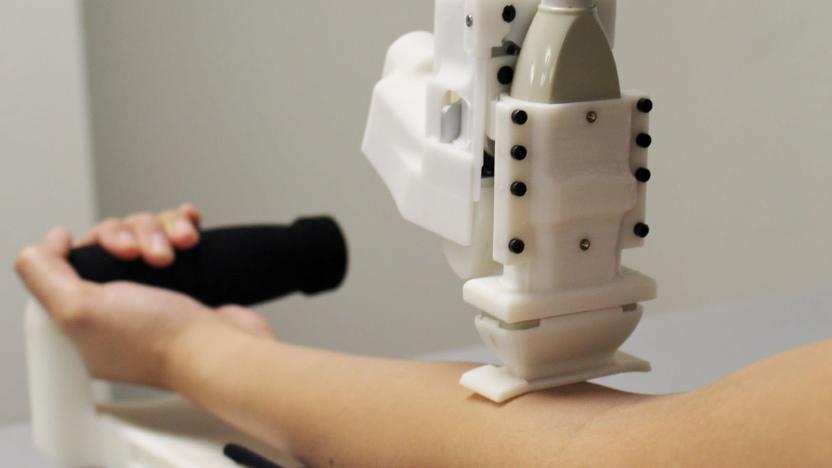veins
Latest

Blood-drawing robot is supposedly more accurate than humans
The only thing worse than getting a needle is getting two (or more) when the first jab attempt fails. Now, researchers from Rutgers and Mount Sinai Hospital have developed a robot that can see under your skin and supposedly do the job better than humans. That could one day help reduce problems like infections and thrombosis when attempting to start an IV line, for example.

ICYMI: Toilet tech, sight-giving headset & lab-grown veins
#fivemin-widget-blogsmith-image-185676{display:none;} .cke_show_borders #fivemin-widget-blogsmith-image-185676, #postcontentcontainer #fivemin-widget-blogsmith-image-185676{width:570px;display:block;} try{document.getElementById("fivemin-widget-blogsmith-image-185676").style.display="none";}catch(e){}Today on In Case You Missed It: Biosynthetic veins and arteries have been created by researchers in London that are able to imitate traits of human tissues, including the ability to self-heal. A headset designed for people with serious vision problems costs a hefty $15,000 but is able to modify sight for users by sending a tweaked for color and focus livestream of reality back to the display. And a Kickstarter gadget aims to tech out your toilet to actually smell okay rather than like... well you know.

Evena's smart glasses offer nurses a through-the-skin view of patients' veins (video)
It's not always easy for nurses to find the right vein for an intravenous drip -- the target vessels are sometimes hidden below the skin. Evena Medical's new Eyes-On smart glasses may make those injections a little easier. The Moverio-based eyewear overlays a 3D blood vessel map on the patient, helping the nurse insert even a tricky IV line on the first try. It can also tap into a hospital's medical records and share imagery with doctors in remote locations. There's no word on just which hospitals will use Eyes-On when it ships in the first quarter of 2014, but don't be surprised if it makes your hospital stay a little more bearable in the near future. Check out a video promo for the glasses after the break.

Researchers use 3D printer, sugar, to create a fake artery network for lab-grown tissue
Printing a chocolate heart is easy enough, but how about an actual organ? There are folks working on it, but it turns out those veins of yours aren't exactly a breeze to replicate. Researchers at the University of Pennsylvania and MIT may have found a semi-sweet solution -- dissolving a sugar lattice in a batch of living Jell-O. The research team uses a RepRap 3D printer and a custom extruder head to print a filament network composed of sucrose, glucose and dextran which is later encased in a bio-gel containing living cells. Once the confectionery paths are dissolved, they leave a network of artery-like channels in their void. Tissue living in the gel can then receive oxygen and nutrients through the hollow pipes. The research has been promising so far, and has increased the number of functional liver cells the team has been able to maintain in artificial tissues. These results suggest the technique could have future research possibilities in developing lab-grown organs. MIT Professor Sangeeta Bhatia, who helped conduct the effort, hopes to push the group's work further. "More work will be needed to learn how to directly connect these types of vascular networks to natural blood vessels while at the same time investigating fundamental interactions between the liver cells and the patterned vasculature. It's an exciting future ahead." Scientists at other labs could also get their mitts on the sweet templates since they're stable enough to endure shipping. Head past the break for a video of the innard infrastructure.

Scientists develop blood swimming 'microspiders' to heal injuries, deliver drugs
Scientists at Penn State would like to release tiny spiders into your blood -- no, it's not the premise for a new horror movie, but rather, it's a medical breakthrough. The spider-like machines are less than a micrometer wide (just so you know, a red blood cell is around six to ten micrometers), and are designed to travel through veins delivering drugs and a little TLC to damaged areas -- not a totally new concept, per se, but even minor advancements can open up all sorts of new doors for troubled patients. Made of half gold, half silica, these microspiders are self-propelled by a molecule called the Grubbs catalyst, which scientists can control directionally using chemicals. Although still in the preliminary phases, lead researcher Ayusman Sen hopes to one day attach the creepy crawlers to nanobots, which could maneuver through the body to detect tumors, helping the immune system and scrubbing vessels clean of plaque. Not like that's doing anything to diffuse your arachnophobia, but hey...

Hitachi builds 3mm-thick vein scanner in its Transylvanian lair
Hitachi has always been hot for vein authentication modules, and its latest iteration takes the whole tech down to just three millimeters in thickness. Given that the current generation requires 23.5mm (nearly an inch) of space to operate in, it's easy to see why your netbook doesn't have one, but Hitachi hopes that's all about to change. Using a CMOS sensor to take almost instant readings, the vein scanner is deadly accurate -- there's only a one in a million chance of it authorizing the wrong person. Volume production is expected within two years, meaning that by 2011 you'll finally have a reliable way to keep your parents out of your "Misc" data folders.




